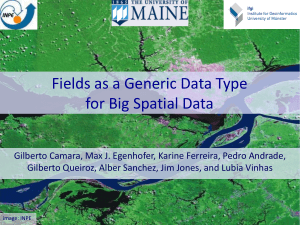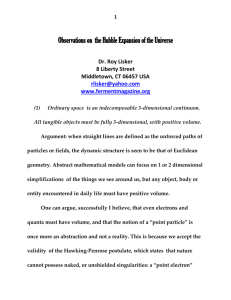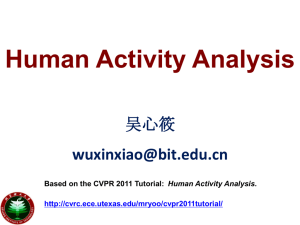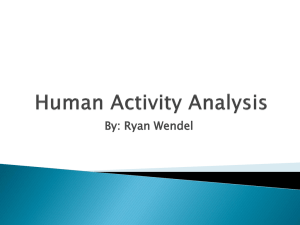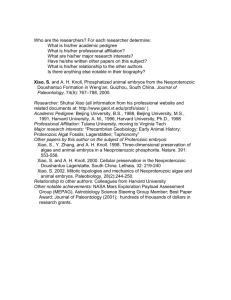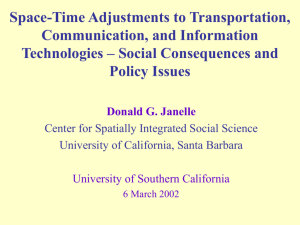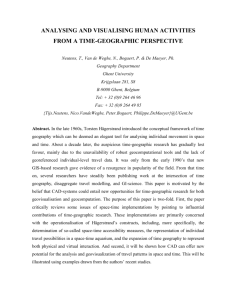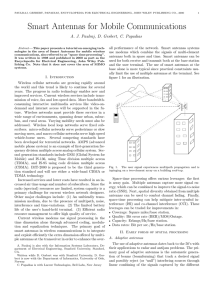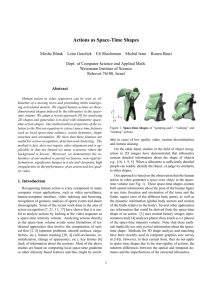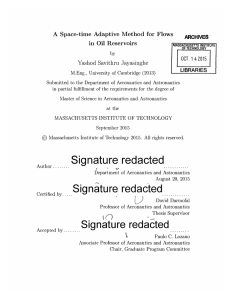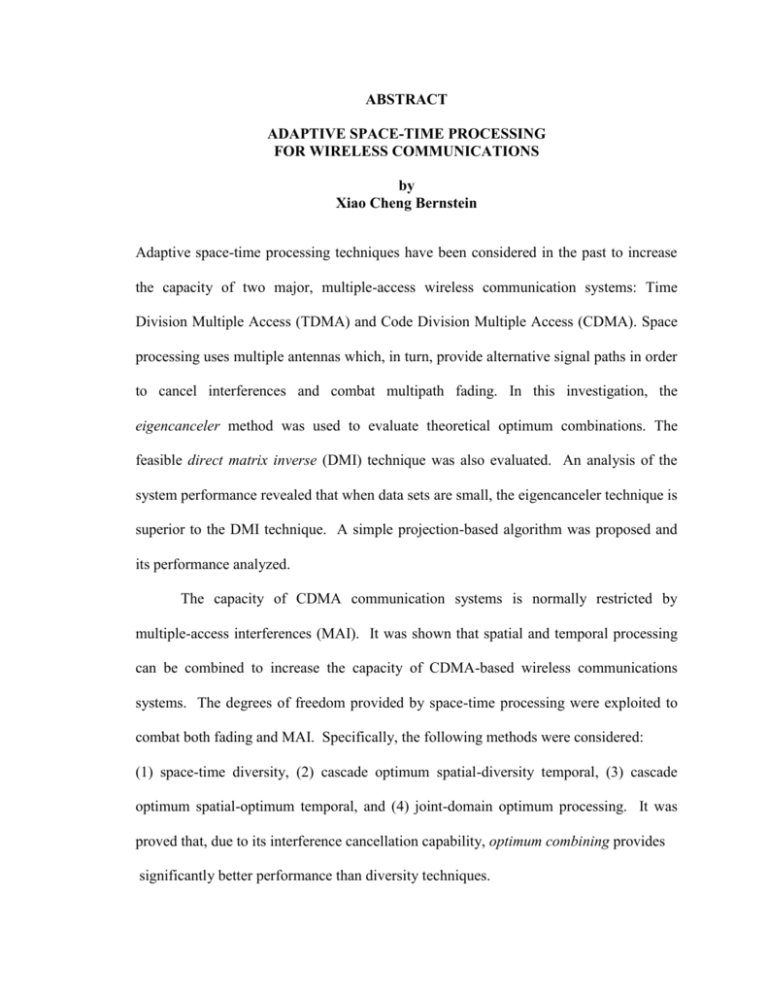
ABSTRACT
ADAPTIVE SPACE-TIME PROCESSING
FOR WIRELESS COMMUNICATIONS
by
Xiao Cheng Bernstein
Adaptive space-time processing techniques have been considered in the past to increase
the capacity of two major, multiple-access wireless communication systems: Time
Division Multiple Access (TDMA) and Code Division Multiple Access (CDMA). Space
processing uses multiple antennas which, in turn, provide alternative signal paths in order
to cancel interferences and combat multipath fading. In this investigation, the
eigencanceler method was used to evaluate theoretical optimum combinations. The
feasible direct matrix inverse (DMI) technique was also evaluated. An analysis of the
system performance revealed that when data sets are small, the eigencanceler technique is
superior to the DMI technique. A simple projection-based algorithm was proposed and
its performance analyzed.
The capacity of CDMA communication systems is normally restricted by
multiple-access interferences (MAI). It was shown that spatial and temporal processing
can be combined to increase the capacity of CDMA-based wireless communications
systems. The degrees of freedom provided by space-time processing were exploited to
combat both fading and MAI. Specifically, the following methods were considered:
(1) space-time diversity, (2) cascade optimum spatial-diversity temporal, (3) cascade
optimum spatial-optimum temporal, and (4) joint-domain optimum processing. It was
proved that, due to its interference cancellation capability, optimum combining provides
significantly better performance than diversity techniques.
ADAPTIVE SPACE-TIME PROCESSING
FOR WIRELESS COMMUNICATIONS
by
Xiao Cheng Bernstein
A Dissertation
Submitted to the Faculty of
New Jersey Institute of Technology
in Partial Fulfillment of the Requirements for the Degree of
Doctor of Philosophy in Electrical Engineering
Department of Electrical and Computer Engineering
January 1996
Copyright © 1996 by Xiao Cheng Bernstein
ALL RIGHTS RESERVED
.
APPROVAL PAGE
ADAPTIVE SPACE-TIME PROCESSING
FOR WIRELESS COMMUNICATIONS
Xiao Cheng Bernstein
Dr. Alexander M. Haimovich, Dissertation Advisor
Associate Professor of Electrical and Computer Engineering, NJIT
Date
Dr. Yeheskel Bar-Ness, Committee Member
Distinguished Professor of Electrical and Computer Engineering, NJIT
Date
Dr. Michael Porter, Committee Member
Professor of Mathematics, NJIT
Date
Dr. Zoran Siveski, Committee Member
Assistant Professor of Electrical and Computer Engineering, NJIT
Date
Dr. Jack H. Winters, Committee Member
Member of Technical Staff, AT&T Bell Laboratories, Holmdel, NJ
Date
BIOGRAPHICAL SKETCH
Author:
Xiao Cheng Bernstein
Degree:
Doctor of Philosophy
Date:
January 1996
Date of Birth:
November 3, 1965
Place of Birth:
Shanghai, P. R. China
Undergraduate and Graduate Education:
Doctor of Philosophy in Electrical Engineering,
New Jersey Institute of Technology, Newark, NJ, 1996
Master of Science in Electrical Engineering,
Shanghai Jiao Tong University, Shanghai, P. R. China, 1991
Bachelor of Science in Electrical Engineering,
Shanghai Jiao Tong University, Shanghai, P. R. China, 1988
Major:
Electrical Engineering
Presentations and Publications:
Xiao C. Wu and Alexander M. Haimovich, “Adaptive arrays for increased performance
in mobile communications,” The Sixth International Symposium on Personal,
Indoor and Mobile Radio Communications (PIMRC’95), Toronto, Canada,
September 1995.
Xiao C. Wu and Alexander M. Haimovich, “Space-time processing for CDMA
communications,” Proceedings of the 1995 Conference on Information Science
and Systems, Baltimore, MD, pp. 371-376, March 1995.
Xiao C. Wu and Alexander M. Haimovich, “A simple projection based adaptive array
with applications to mobile communications,” Proceedings of the 1994 Adaptive
Antenna Systems Symposium, Melville, NY, pp. 37-42, November 1994.
iv
< Write personal dedication >
< Samples are available in the Office of Graduate Studies >
v
ACKNOWLEDGMENT
The order for this section is as follows: Thesis or Dissertation Advisor, Committee
members, Funding source and Technical support. Many students include peers (by name
please) who were key to their success and some also finish with family members.
vi
TABLE OF CONTENTS
Chapter
Page
1 INTRODUCTION……............................………………..………………………….
1
1.1 Objective ……............................………………..……………………………...
2
1.2 Background Information …………….…………………………………….…...
2
2 SPATIAL PROCESSING FOR TDMA SYSTEMS ……………………………….
7
2.1 Problem Statement ……………………………………………………………..
8
2.2 Eigenanalysis Filter Information ……………………………………………….
11
3 IMPLEMENTATION ………………………………………………………………
28
3.1 Adaptive Algorithms for the Eigencanceler ………………………………...…
28
3.1.1 Projection Algorithm …………………………………………………....
28
3.1.2 Power Method ……...…………………………………………………....
30
3.2 A Stochastic Model For The Convergence Behavior of the Affine Projection
Algorithm for Gaussian Inputs……………………………………………………....
31
4 SPACE-TIME PROCESSING FOR CDMA COMMUNICATIONS ……………...
37
4.1 Signal Model ………………………………………………………………...…
37
4.2 Space-Time Combining Schemes ………………………………………….…..
42
4.2.1 Spatial Combiner …………………………………………………..……
42
4.2.2 Space-Time Combiner .……………………………………………..…...
44
4.2.3 Test Preparation .……………………………………………..….............
46
4.2.4 Wear Rate .……………………………………………..….......................
47
4.2.5 Friction Regimes .……………………………………………..…............
50
vii
TABLE OF CONTENTS
(Continued)
Chapter
Page
4.2.6 Antiwear Additives .……………………………………………..…........
52
5 CONCLUSION .…………….……………………………………………………...
57
APPENDIX A MATLAB SOURCE CODES FOR DETECTION WITH
WAVELETS…………………………………………………………..
91
A.1 Signal Model ..……………………………………………………………...…
91
A.2 Space-Time Combining Schemes ...……………………………………….…..
92
APPENDIX B CORRELATION OF CDMA SIGNALS ...…………………………...
93
B.1 Signal Model ..……………………………………………………………...…
93
B.2 Space-Time Combining Schemes ...……………………………………….…..
96
REFERENCES ………………………………………………………………………...
98
viii
LIST OF TABLES
Table
Page
2.1
Frequency Reuse Factor and CIR…....………………..………………………….
24
2.2
Optimization Mechanism……….…....………………..………………………….
29
2.3
Communication System………...…....………………..………………………….
34
3.1
Cascade Space-Time Receiver Configurations...……..………………………….
46
4.1
Signal to Noise Ratio...…………………………………………………………...
51
4.2
Channel Model……………………………………………………………………
53
4.3
Performance of ST Receiver as a Function of Number of Active Users L…...…..
55
4.4
Performance of ST Receiver as a Function of Number of Ratio q......……….…..
56
4.5
Performance of ST Receiver as a Function of Number of Ratio p...……………..
56
4.6
Outage Probability vs. the Capacity with Perfect Power Control…..…………….
70
ix
LIST OF FIGURES
Figure
2.1
Page
The average BER vs. the average received SNR with one Interference INR=2
dB and (a) K=20, (b) K=50 (Analytical Results) ………..……………………….
17
The average BER vs. the average received SNR with on interference (simulation
results) ………………..…………………………………………………………..
29
3.2
IS-54 Data Model ..…..………...…....………………..…………………………..
31
3.3
IS-54 Slot Formats ...……..………………………………………………………
31
4.1
IS-136 System…..………………………………………………………………...
49
4.2
Channel Model……………………………………………………………………
53
4.3
Performance of ST receiver as a function of number of active users L...………...
55
4.4
Performance of ST receiver as a function of number of ratio q…...……………...
56
4.5
Performance of ST receiver as a function of number of ratio p…………...……...
56
5.1
Outage probability vs. the capacity with perfect power control….………………
70
3.1
x
LIST OF SYMBOLS
©
Copyright
∫
Integration
Å
Angstrom (10-10 meters)
SAR
Specific Absorption Rate
Π
3.415
♀
Female
®
Registered
≈
Approximately
♠
Spade Suit
∂
Partial Differential
#
Number Sign
¢
Cent Sign
xi
LIST OF DEFINITIONS
Accuracy
How closely an instrument measures the true or actual value
of the process variable being measured or sensed.
Acidic
The condition of water or soil which contains a sufficient
amount of acid substances to lower the pH below 7.0.
Alkaline
The condition of water or soil which contains a sufficient
amount of alkali substances to raise the pH above 7.0.
Analog
The readout of an instrument by a pointer (or other
indicating means) against a dial or scale.
Cohesion
Molecular attraction which holds two particles together.
Effective range
That portion of the design range (usually upper 90 percent)
in which an instrument has acceptable accuracy.
Linearity
How closely an instrument measures actual values of a
variable through its effective range; a measure used to
determine the accuracy of an instrument.
Surfactant
Abbreviation for surface-active agent. The active agent in
detergents that possesses a high cleaning ability.
Standard
A physical or chemical quantity whose value is known
exactly, and is used to calibrate or standardize instruments.
xii

